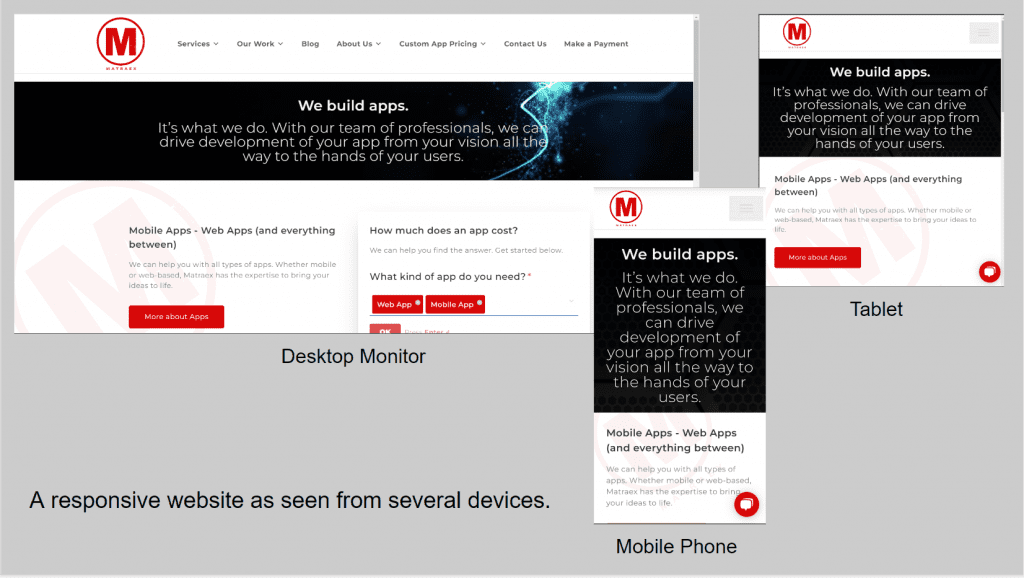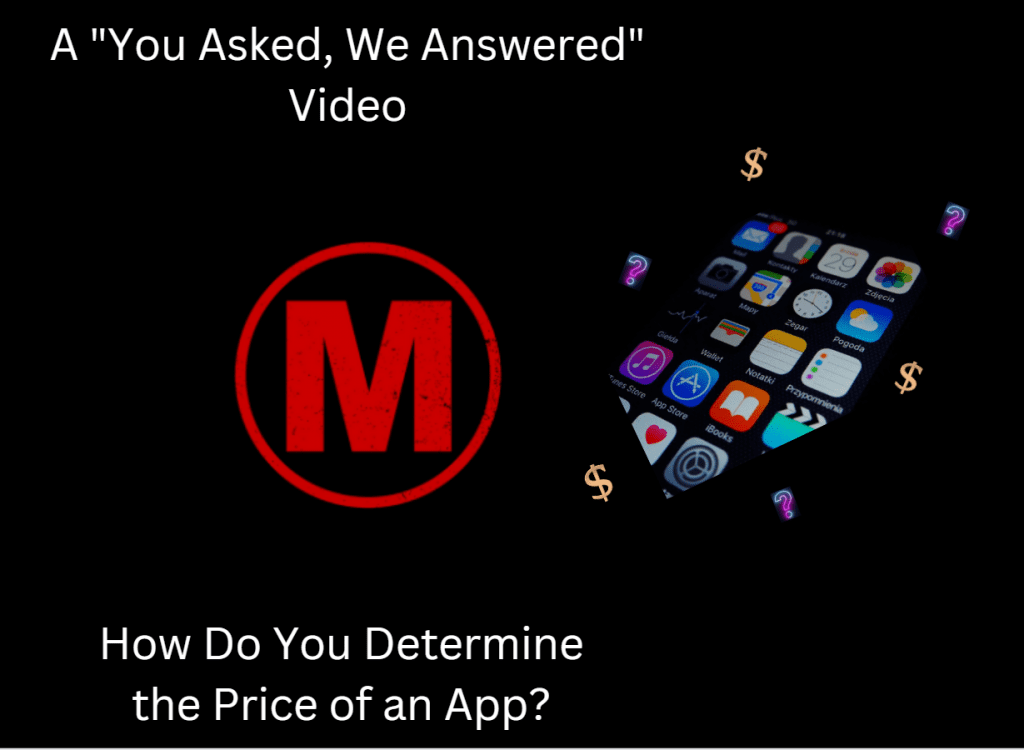Tag: app development
What Is ADA Compliance in Regards to Digital Services?

An ADA compliant website or digital service is designed to be accessible to people with disabilities. These disabilities include those with visual, auditory, physical, speech, cognitive, and neurological disabilities.
To be ADA compliant, a website must be designed and coded in a way that allows people with disabilities to access the content on the site without difficulty. Compliance applies to all digital services including both desktop applications, mobile applications, and video.
Digital media must also provide features such as alternative text for images and captions for audio and visual content, keyboard navigation, and support for assistive technologies such as screen readers. The software development team needs to keep the UX/UI design in mind when developing the website or app so it includes these options.
The following questions are answered in this article:
- When did ADA compliance become law?
- What are the top 10 qualities a website or other digital service must have to be ADA compliant?
- Are ADA digital compliance laws being enforced?
- What websites and apps are mandated to be in compliance with Section 501?
- What can happen if a website or app is not ADA compliant?
When did ADA compliance become law?
In 1998, the Americans with Disabilities Act (ADA) was amended to include Section 501, a provision for website accessibility. Section 501 made it illegal for any publicly accessible website or digital service to discriminate against people with disabilities.
It also required that websites and other digital services including apps provide an accessible experience for disabled users so it needs to follow accessibility guidelines. This legislation was among the first of its kind. It set the foundation for other countries and the World Wide Web Consortium (W3C) to create their own website accessibility standards.
There are no websites or digital services that are considered exceptions to the ADA compliance laws. Compliance applies to all websites and digital services regardless of size, industry, or purpose.
What are the top 10 qualities a website or other digital service must have to be ADA compliant?
Keep in mind that the specifics that need to be done for each piece of digital service or digital medial is going to be a bit different. Despite differences, the end goal is the same: to make digital services and media accessible to everyone regardless of handicap or disability. Qualities that all should have, however, include the following:
- The digital media must be easy to navigate with clear and consistent navigation options. This includes a clear page structure and easy to understand headings and labels. The user must also be able to skip repetitive navigation elements.
- All images, graphics, and videos should have alt text that accurately describes the content. This allows people who are visually impaired to understand the content of the page.
- A page should have structured markup to communicate the structure and hierarchy of the page. This can include proper use of heading and subheading tags.
- The fonts used in a website should be easy to read. A minimum font size of 12 points is recommended, though that can differ from one digital service to the next.
- A website or app should be able to be navigated in its entirety through the use of the keyboard. This also applies to a mouse or other pointing device. This includes the ability to navigate a website through tabs and keyboard shortcuts. Assistive technologies that currently exist, such as screen readers, must be also be supported.
- The content on a website or app should have a high contrast ratio between the background and any text. This makes it easier for someone with low vision or color blindness to read.
- Fields on forms should be labeled accurately and the labels should be associated with the fields. This allows devices such as screen readers to understand what information is being requested of the user.
- Time-based events on websites and other forms of digital media should have alternate ways of accessing the content. If this cannot be accomplished, there needs to be a way for the user to turn off the event.
- Audio and video content should have closed captions and/or transcripts as well as an audio description of the content. This will allow hearing or visually impaired individuals to access the digital content.
- When error messages pop up, they should be clear and descriptive and should not be hidden. This way, users can understand why a website or app error occurs and how they can fix it.
Are ADA digital compliance laws being enforced?
The Department of Justice (DOJ) is the entity responsible for enforcing ADA. Right now, there are not any specific deadlines when compliance will be strictly enforced across the board.
Despite that, the DOJ has begun to take action against websites and other digital media that are not in compliance. Right now, this primarily happens when particular websites and apps are brought to their attention as being discriminatory. The number of lawsuits being filed over website accessibility for individuals with disabilities is increasing all of the time. Over 2,500 lawsuits were filed in 2020 alone.
In some cases, state and local governments are also beginning to enforce the law on a case by case basis.
What websites and apps are mandated to be in compliance with Section 501?
Under Title 1 of the ADA, any business, organization, or institution with at least 15 full-time employees that operates for 20 or more weeks per year is required to comply with Section 501.
The Justice Department has not begun cracking down on Section 501 violators as of yet, however. So far, the Justice Department has been handling non-compliance issues of individual businesses and organizations as specific non-compliance issues are brought to their attention by users. Users can file complaints on the Department of Justice’s Civil Rights website if they feel as though their rights were violated.
This is not true in every circumstance, however. The U.S. Department of Justice’s 2010 ADA Standards for Accessible Design became enforceable on March 15, 2012. Therefore, so all federal government digital media should now be in compliance with Section 501.
In addition, any business vying for a federal contract or who receives Federal funds for any reason should now be in compliance with this provision. Funds could be pulled and contracts could be rejected, in addition to receiving fines for the violation, if a business’s website or app is not ADA compliant.
What can happen if a website or app is not ADA compliant?
Even though it is not yet enforced across the board, if a website or app is not ADA compliant, it can lead to the website being deemed discriminatory. This can lead to a variety of legal, financial, and reputational consequences including costly fees, settlements, judgments, costly legal fees, and being pulled from the mobile app stores. A first violation can cost up to $75,000 and subsequent violations can be $150,000 for each occurrence. In addition, if a website is not ADA compliant, the ADA may require that the business meet a higher standard of accessibility than what is currently required as part of their penalty.
In addition, businesses could lose customers and revenue if those with disabilities cannot access the digital service. Without access, disabled individuals may be unable to purchase goods or services from the website or app, which could lead to a decrease in sales.
Reputational consequences may also arise from not being ADA compliant. Businesses may be seen as not respecting the rights of those with disabilities or for not being socially responsible. This could potentially lead to a decrease in customer loyalty and public trust in the company which, in turn, could cause a decrease in revenue.
Matraex is a premier web and app development company headquartered in Boise, Idaho. Matraex wants to be your go-to resource for web and app development questions.
Have a tech question? Contact us, leave us a note through the messaging feature on our website, or post a question to our Google Business Profile. You can even give us a call at (208) 344-1115.
We look forward to answering all of your questions so you can be an informed tech consumer.
Sign up to receive answers to your questions delivered directly to your inbox!
Video Blog: How Do You Determine the Price of an App?
Why Do App Development Companies Sign NDAs with Clients?

When you have an idea for a web app, mobile app, or special web design and go to an app development team to discuss the concept, it often isn’t long before the company requires you to sign a non-disclosure agreement (NDA).
There are many reasons, but it boils down to this: an NDA protects the intellectual property of both parties. An NDA reduces the chances of one party taking advantage of the other. It also establishes trust between the developer and the client, and protects the brand and reputation of both parties.
This article will answer the following questions:
What is a non-disclosure agreement?
A Non-Disclosure Agreement (NDA) is a legally binding contract that two or more parties sign (in this case the app founder and app development company) that protects confidential information from being shared with third parties. It helps to ensure that both sides will not disclose information to others.
In the case of an app development company and an app founder, an NDA is frequently initiated by the app development company, but that is not always the case. If the founder’s business, organization, or institution is a government entity, works closely with the government, or has trade secrets or other sensitive information that will be discussed during the building of the app, they may require their own NDA to protect their interests.
What are the different types of NDAs?
There are two types of non-disclosure agreements that an app founder and the app development company can sign:
- A unilateral or one-way NDA, which is designed to protect only one of the two parties involved. Employers sometimes require that new employees sign a unilateral NDA. This is also true when a company hires a contractor or if an inventor goes to a company to have an idea or invention evaluated.
- A bilateral or mutual NDA, which is designed to protect both parties equally. Both parties can limit how the other party will use or share their information. This is the type of NDA that app developers usually require.
How are NDAs written?
An NDA has three primary components:
- The parties involved. An NDA defines who is bound by the agreement and their obligations to each other.
- The confidential information. This section outlines the confidential information that the parties agree to keep secret. This can include trade secrets, ideas, techniques, processes, product information, and other proprietary information.
- The restrictions. This section outlines the specific restrictions on how the confidential information can be used and shared. It covers how long the agreement is in effect for and how the information can be shared, along with any other restrictions the two parties decide on.
For an NDA to be legally binding, it must include these three components. It must also be signed by all of the parties involved. In addition, most NDAs include language that allows for the agreement to be enforced in a court of law if necessary.
In order for an NDA to be legally binding, all parties must also have a clear understanding of the agreement and sign it voluntarily. It should be written in simple, understandable language that all parties can understand, and all parties should have the time needed to review the agreement and consider the terms before signing it.
As an app founder, what does an NDA do for me?
An NDA aids the app’s founder and the founder’s company in addition to the project manager in a number of ways:
- It shows the commitment of the app development company to protect confidential information and to the success of the project. This can help to foster a more productive relationship between the two parties.
- It establishes trust between the app founder and the development company they have chosen to work with.
- It promotes an environment that allows an app founder to talk freely about his vision without worrying that his idea could be stolen or is in jeopardy.
- It protects the founder’s intellectual property and any confidential information that may be contained in the app itself.
- It can prevent the founder’s competitors from obtaining access to the app’s ideas, designs, and other proprietary information and using it for their own advantage.
- It provides a legally enforceable means of protecting confidential information. It also limits the use of such information by the development company to ensure that their information is not misused.
How does a NDA help the app development company?
In addition, an NDA assists the software development firm in several ways:
- It ensures the confidentiality of an app developer’s intellectual property including their source code, programming language, software designs, and other proprietary information. By doing this, the NDA protects the developer’s ideas, designs, and developments from being stolen by competitors or malicious actors.
- NDAs can also help the development company from potential lawsuits or breach of contract claims from disgruntled clients.
- An NDA protects development companies from revealing sensitive information to their clients. This includes their development process, which protects the development company’s competitive advantage over its competitors.
- By signing an NDA, a client agrees to pay for the services provided and not use intellectual property without permission. This provides the development company with the assurance that they will be compensated for their hard work and that the client cannot take advantage of them.
What action can be taken if a NDA is violated?
If an NDA is violated, the injured party may take legal action against the other party. This would most likely be done through a civil case, and there have been instances when such action has gone all of the way to the Supreme Court. This action can include filing a lawsuit in a civil court and seeking a court order to prevent further violations. The affect party can also seek a monetary award for damages incurred by the violation.
The first step to taking legal action against a company who violated a non-disclosure agreement is to contact an experienced attorney. The attorney will review the contract and determine what legal remedies are available and how to best proceed.
The next step is to prepare a demand letter. The letter should include details of the breach and damages that were suffered as a result of the breach. It should also request for the company who caused the breach to take corrective action. In addition, the demand letter should state what legal action may be taken by the injured party if the company does not take corrective action.
If the company does not take corrective action after receiving the demand letter, the injured party may choose to file a lawsuit in civil court. The lawsuit should include all relevant facts, a statement of damages suffered, and a request for a court order to prevent further violations of the NDA.
If the court finds that the NDA was violated, it can award damages to the party affected by the breach. Depending on the particular circumstances, these damages may include monetary compensation, attorney’s fees, and court costs.
Finally, the court may issue an injunction ordering the company to stop further violations of the NDA. This injunction would require the company to take specific steps to ensure that it is in compliance with the agreement.
Matraex is a premier mobile and web app and software development company headquartered in Boise, Idaho. Do you have any questions about app development, web development, or technology in general? Matraex would love to answer them! Your question may even be featured in a future blog!
Contact us, leave a question in the instant messaging feature on our website, or put a question on our Google Business Page. We look forward to helping you become a more informed consumer.
Sign up to receive answers to your questions delivered directly to your inbox!
How Do You Add Color to Websites and Apps?

When the average person looks at the coding involved in a website or app, it often looks like lines and lines of gibberish. How in the world can a programmer make sense of it? But, of course, it does make sense to them. As for adding colors to websites and apps, there are standardized words that can be used for some colors. The most common way with the larger variety of colors, however, is by using Hex Codes. Another way to add colors, which is very similar to Hex Codes, is by using RGB colors.
Questions answered in this article include the following:
What colors can I make using specialized words?
In some cases, depending on the color you are searching for, you can sometimes add the name of the color directly inside the code. There are 140 standard color names that can be used when coding. Here’s an example of the standard color names.

You can visit htmlcolorcodes.com for a chart with all 140 specific color names available to use in coding.
How is Hex Code used to create different colors?
Using Hex Codes, also called Hexadecimal Colors, is the most common way of adding colors to a website or app, and it has a much larger variety of colors. Hexadecimal codes are formed from a number sign and six digits #RRGGBB (red, green, blue). Each digit then has a number or letter 0-9, A-F. The farther you go from the 0 to the F, the higher the intensity of that color. The color white is the highest intensity, represented with #FFFFFF and black being the lowest intensity, represented by #000000. All of the gray colors have the same two digits repeating such as #676767.
When using Hex Codes, it is possible to create 16,777,216 colors! If you would like to experiment with Hex Codes, this color picker shows the range of possible colors with its corresponding Hex Code. It shows the RGB codes for each color as well.
How do RGB colors work?
RGB (red, green blue) colors work the same way as Hex Code but may be a little simpler to understand. Instead of using two digits with a combination of numerical digits and letters up to F to denote the intensity of the colors, RGB colors use the numbers 0-255, with 0 being the lowest intensity and 255 being the highest. Therefore, RBG(0, 0, 255) would be green since the green has the highest intensity while the other two colors are zero. Subsequently, RBG(0, 0, 0), with all three colors being the lowest intensity, would be black and RBG(255, 255, 255) would be white, with all three colors being the highest intensity.
As with Hex Codes, there’s 16,777,216 possible colors when using RGB colors, and you can also experiment with the color picker to see the variety of colors with its corresponding code.
What does the code look like when adding colors?
If you are using CSS or HTML as the primary coding language, it’s not much different. You would add your color choice before the text. So, for example, you wanted to write “How are you?” in an H2 setting with a background Hex color of red, you would write:
<h2 style=”background-color:#ff0000;”>How are you?</h2>
W3Schools has tutorials on a number of coding languages with ways that you can try your code and see the results. You can go there to see examples of how colors are used in coding and try it out for yourself.
Matraex would like to be your go-to source for information regarding app development or anything coding or tech-related. Feel free to send us a message on our website, contact us, or leave us a question on our Google Business Profile. We look forward to answering your questions so you can be informed.
Sign up to receive answers to your questions delivered directly to your inbox!
When using AWS, what tools and services are essential for my app?

Amazon Web Services (AWS) is a cloud-based computing platform owned by Amazon.com. It provides services and tools for software developers that allow them to concentrate on coding without needing to worry about the required infrastructure that must be in place for them to do so. The types of services that AWS provides include compute services, storage services, database services, networking services, management services, analytics services, security services, and application services. The tools and services that AWS offers are vast, with over 200 currently to choose from. If you choose to use the AWS platform to develop your app, however, there are a few specific services that are utilized by just about every app that is developed. They include the following:
- Amazon EC2 (Amazon Elastic Compute Cloud)
- Amazon EBS (Elastic Block Storage)
- Amazon S3 (Amazon Simple Storage Service)
- Amazon RDS (Amazon Relational Database Service)
In this article, we will give an explanation of each service as well as what the potential cost of using the service might be.
Amazon Elastic Compute Cloud (EC2)
Amazon EC2 provides secure, resizable compute capacity in the cloud which basically amounts to users renting virtual machines. Each virtual machine, which is called an “instance,” is then loaded with the operating system of the user’s choice and can be used to run applications, to store and process data, and to host websites. Amazon EC2 can also be used to launch apps quickly and efficiently and to manage them across multiple servers.
Amazon EC2 provides a wide selection of instance types which include the following:
- Amazon EC2 A1 Instances. Powered by AWS’s custom-designed Graviton2 processors. They are optimized for scale-out workloads such as containerized microservices, web servers, gaming, and media processing.
- Amazon EC2 C5 Instances. Optimized for compute-heavy workloads. They are the ones to consider for high-performance computing, machine learning, and video encoding.
- Amazon EC2 M5 Instances: Designed for general purpose workloads such as web servicers, batch processing, and gaming.
- Amazon EC2 R5 Instances. Optimized for memory-intensive workloads such as in-memory database, distributed web scale in-memory caches, and real-time big data analytics.
- Amazon EC2 T3 Instances. Designed for burstable workloads such as web servers, development environments, and small databases.
For these instances, the user can choose from varying combinations of CPU, memory, storage, and networking capacity. This allows the user to pick the mix of resources that will best meet their needs. It also provides users with a range of security and networking options which allows them to configure their instances to meet their specific security and networking requirements. Amazon EC2 is designed to help businesses scale and grow by providing access to as much power as they need on demand and by charging for only the memory that is used. It also completely eliminates the need for expensive hardware that can take long amounts of time to set up and configure.
AWS offers a free tier of EC2 Linux and Windows micro instances for the first 12 months of service which includes 750 hours of service per month. EC2’s prices vary depending on the instances chosen and the time you spend using the instance. They charge by the hour or the second depending on the instance you run. There are no upfront payments or commitments required. To save money, AWS also offers spot instances. Spot instances use spare Amazon EC2 computing capacity at a huge discount. You can also sign up for their savings plan, which will provide a discount for using a consistent amount of usage over an extended period of time. To qualify for the savings plan, you do have to sign a commitment.
Amazon Elastic Block Storage (EBS)
Amazon EBS provides block-level storage for the data associated with the applications that are run by Amazon EC2. It is basically a virtual hard drive. Amazon EBS stores data that needs to be accessed quickly and frequently. This data can include databases, log files, application data, and media files and is persistent. This means that the data will remain there even if the computer or server it is being served from is powered down.
Amazon EBS tends to be more reliable than traditional hard drives and has a number of other advantages:
- It can also be accessed from anywhere since the information is stored on the cloud.
- It can be resized without taking the instance that is being used offline.
- It can be backed up and restored with just a few clicks.
- The data on an EBS system can be moved from one EC2 instance to another.
In order for Amazon EBS to be used with an instance, a user must determine the volume or capacity that is needed and attach it to an instance in Amazon EC2.
AWS offers a free tier of EBS which includes 30 GB of storage per month in addition to 2 million input/output operations per second (IOPS) and 1 GB of snapshot storage. Snapshot storage are point-in-time copies of your block data. If you go over the 30GB of free storage, the standard charge is $0.05/GB-month. EBS also offers different types of storage, all of which come with their own price.
Amazon Simple Storage System (S3)
Amazon S3 is a cloud storage platform that provides an easy way to store and retrieve files from the cloud. It can be accessed anywhere there is an internet connection and is ideal for storing large amounts of data such as photos, videos, music, and documents among other files. It is also cost effective because the user only pays on the actual amount of data being stored.
Data stored using S3 are placed into large “folders” called buckets. To use S3, you create a bucket, assign it a name, set its permissions and access controls, and then assign data to it. The user can control who has access to their data and set up automatic backups. The items placed in the bucket are encrypted, highly secure, and are available via the internet using HTTP.
When using S3, you pay to store items in your buckets, and the rate you’re charged has many variables to consider. Those variables include the size of the items you’re storing, for how long you are storing them. S3 also has different storage classes which are based on how often you need to access your data, and the rate varies depending on the class or classes you choose. AWS offers a pricing calculator that will help you get an estimate of the AWS services you intend to use.
Amazon Relational Database Service (RDS)
Amazon RDS is a cloud-based service that provides users with a relational database for their applications. In a relational database, data is organized into tables with columns and rows. The columns represent attributes of data and the rows contain records or instances with those attributes. This allows users to quickly and easily access data from multiple sources without needing to search through multiple tables or needing to install and manage a database. Amazon RDS also allows users to easily replicate and make backups of their data.
Amazon charges for RDS services based on the total data that is transferred from all sources for backups, replication, and access over the Internet. The price is also dependent on the instance types you have, your database engine, and the regions in which the data is stored. Using RDS can sometimes become a bit somewhat pricey. If you are on a budget or just wish to avoid the cost, you can look into using MySQL instead and determine whether it may suit your needs. MySQL is open-source and free, but it requires users to have a good understanding of database concepts and administration. MySQL will not always be a suitable alternative, however, and RDS does charge to run MySQL. Plus, switching from one relational database service to the other can be difficult, costly, and result in lost data, so you may want to wisely choose which service to use. It is often best to choose which one you believe will suit your needs and then stick with it.
Matraex is a premier app and software development company located in Boise, Idaho. We want to help you become informed in app development concepts so you can make informed decisions and be a consumer who is “in the know”. Feel free to leave us a question on our Google Business Profile, contact us with your questions, or leave a message in the chat feature on our website. We look forward to answering your questions.
Sign up to receive answers to your questions delivered directly to your inbox!
What Is a Responsive Website?

A responsive website is a website that is designed to respond to the user’s behavior and environment based on the screen size, platform (desktop monitor, tablet, phone and so on), and orientation (whether portrait or landscape) of the device they are using. A responsive website uses fluid, proportion-based grids and flexible images to create a dynamic, flexible website that provides a great user experience that looks great on any device.
Questions that will in answered in this article include the following”
- Why is it important to have a responsive website?
- What are the negative consequences of not having a responsive business website?
- What are some common misconceptions about responsive websites?
- How can I tell if my website is responsive?
- If I am using a website builder, do I need to worry about my website being responsive?
- How do I make my website responsive?
Why is it important to have a responsive website?
Websites are viewed in many different ways and on many different devices. Long gone are the days of a website being viewed on a desktop monitor most of the time. The platforms used to access a website depends on the target audience and the content of the website, but the trend for many years has leaned heavily towards mobile devices. According to Oberlo, just ten years ago, over 90% of website traffic occurred on desktop computers. By late 2022, those figures had totally changed. Now, over 60% of all web traffic comes through mobile devices, with over 50% of all website visits coming through such devices.
In addition, more and more people are accessing websites through other internet-capable devices. These devices include wearable devices and their car’s navigation systems among other platforms. It is important that your website can be viewed properly regardless of the device that is being used because it allows users to have a better user experience, and the better the experience, the more likely they will spend more time visiting and interacting with the website. Google also rewards websites that are optimized for mobile devices by ranking them higher in search engine results, so having a responsive website is also important for SEO.
What are the negative consequences of not having a responsive business website?
There are a number of potential negative consequences of a website not being responsive.
- Loss of Traffic: Without a responsive website, some users may find it difficult to access the website on their mobile devices. This could lead to a decrease in website visits. Customers may also be unable to find what they’re searching for on the site.
- Poor User Experience: Since the content and design may not be displayed correctly on mobile devices, users may have a poor experience. This could cause customers to leave the website and not return.
- Lower Search Engine Rankings: Since search engines like Google prioritize mobile-friendly websites, not having an optimized site could result in lower ranking in search engine results. That could make it more difficult for customers to find a business’s website.
- Missed Opportunities. An unresponsive website might miss out on potential customers who use mobile devices to search for products or services. Therefore, it could also miss out on potential sales and leads.
- Reduced Conversions: A website that is not optimized for mobile devices will often have a reduced conversion rate since it is more difficult for customers to complete purchases or take desired actions when using a mobile device.
What are some common misconceptions about responsive websites?
There are several misconceptions about responsive websites which sometimes hold keep website owners from designing their website to be responsive or getting it that way once they discover that the website is unresponsive:
- Responsive Websites Require a Separate URL. A common misconception is that a responsive website requires a separate website address or URL. They actually use the same URL as a non-responsive website, but the content and design of the website is displayed differently depending on the device used to view the site.
- Responsive Website Are More Difficult to Build. Another misconception is that responsive websites are harder to build and therefore require more time, effort, and money than a nonresponsive site. A responsive website may require more planning than a standard website, but it’s still a process that can be completed in a reasonable amount of time.
- Responsive Websites Are Not SEO Friendly. As already discussed, responsive websites are actually more SEO friendly because they are favored by Google. Also, they are better than having separate desktop and mobile websites because they have the same content and code which makes them easier for search engine crawlers to index.
- Responsive Websites Load Too Slowly: Responsive websites can be optimized for speed just like any other website. The speed of a website depends on how it is coded and hosted, not on its design.
How can I tell if my website is responsive?
Many website builders, like WordPress, provide tools that will allow you to “see” what a website will look like on a desktop monitor, on a tablet, and over a mobile phone. It may be a good idea to use those tools regularly, particularly when you make changes to a website, to get an idea of what your website looks like on various devices. These tools are not 100% accurate, however. No tools can account for all possible screen sizes or device types nor can they always accurately reflect the performance of a website in an actual environment.
There are other tools available online as well, such as the Website Responsive Testing Tool, that can help you determine if a website is responsive. Tools such as this site will analyze a website and give you a report on its responsiveness. This can be a helpful way to test a website quickly and easily.
The only surefire way to determine whether a website is responsive, however, is to actually look at it on various devices such as a tablet and a mobile phone. If the website looks different on each device, but all of the content is still readable and it’s easy to navigate, then the website is probably responsive.

If I am using a website builder, do I need to worry about my website being responsive?
If you use a website builder, you should still worry and check for website responsiveness, but it may not be as much of a factor as creating a website from scratch. Many popular website builders such as WordPress, Wix, and Squarespace, among others, come with pre-designed templates that are designed to be responsive, but that doesn’t mean they always are. When designing a website, regardless of method of doing so, you may wish to check your website on different devices to ensure that it is truly responsive.
How do I make my website responsive?
- Add the following ‘meta’ tag to your HTML Head:
<meta name=”viewport” content=”width=device-width, initial-scale=1″>
By doing so, you are styling your meta tag as code. - Some markup languages, such as pure HTML, tend to be responsive by nature, but you are very limited to what you can do with just HTML.
- You can use a CSS Flexbox/Grid. CSS dictates how a document looks and controls its responsiveness, and this will allow you to resize items depending on the size of the screen.
- Add breakpoints that will change the design of the website when it starts looking awkward on different sized devices. This includes having a single column of images and text on narrow-screened devices that changes to two or even three columns on wider screens. You can also use a different font size for different break points to increase its readability.
- Set images and other elements to 100vw. By doing so, the elements will be able to resize with the size of the screen.
Matraex is a software and app development company in the northwestern United States. Do you have any app development or technology questions? We would like to provide unbiased answers so you can feel confident making app development or technology-related questions. Feel free to contact us via our website, leave us a note via the live messaging feature on our website, or call us at (208) 344-1115. We look forward to answering all of your questions so you can make informed decisions that are right for you.
Sign up to receive answers to your questions delivered directly to your inbox!
What Is Amazon Web Services (AWS)?

Amazon Web Services, also known as AWS, is a cloud-based computing platform that is owned and operated by Amazon.com. It offers a wide range of tools and services that can help businesses become more agile and increase their innovation.
AWS Services include computation, storage, analytics, networking, and mobile services. AWS is the world’s most popular cloud computing platform with over a million customers in 190 countries. It is used by businesses, from startups to large corporations, organizations, and institutions to build applications.
AWS allows companies to quickly and easily build, manage, and scale applications and services. It can be accessed from anywhere that has internet access. AWS does this by providing needed infrastructure so developers can focus on their projects.
With AWS, developers do not need to worry about storing and analyzing data, how content is going to be delivered, or where they are going to create code. AWS provides flexible and cost effective solutions to these types of problems. This helps companies reduce cost while increasing efficiency.
Why is AWS useful to app developers?
Amazon Web Services is an important tool for developers. It provides a cloud platform that allows them to quickly create reliable and scalable applications. With its wide range of storage, database, and networking services, it allows developers to write code for their applications without worrying about the underlying infrastructure.
It also provides cost-effective, pay as you go pricing. This makes it attractive for developers who want to build applications quickly and cost effectively. It also allows them to scale their applications at a later date.
Why do developers request administrative access to AWS?
Developers request administrative access to Amazon Web Services to facilitate faster development. While the developers are setting up servers, there is often a complex relationship between the numerous resources and services that need to be established and maintained. Allowing administrative access enables developers to set up those relationships between the different systems without needing to communicate why each system is required.
In addition, it may be difficult for an app owner or manager to understand the technicalities involved with AWS and the relationships that needs to be established between different services. It may be simpler, faster, and less confusing to give the developer the access they need. AWS offers foundational services including compute power, network, storage, gateway load balancing, and data warehouse services. AWS offers over 200 total services, which can be overwhelming and confusing.
Administrative access to AWS is also requested so developers can manage advanced security systems. They may also need administrative access so they can monitor and troubleshoot issues when they arise. Without access, they would need to request individual permissions every time something new comes up.
Do developers require administrative access to AWS?
App and software developers may not require administrative access to AWS, but without it, the product owner or product manager may need the knowledge to manipulate some of the AWS services on their own. Without administrative access, the product owner or manager may also need to give multiple permissions for individual access to various AWS tools and services as their app is being developed.
If the developer cannot access to the tools and services they need to implement and integrate into the app and does not give the developer permission, the product owner or manager would need to do it themselves.
What are the most commonly used tools and services of AWS?
The most common features of Amazon Web Services include the following:
- Amazon Elastic Compute Cloud (EC2): A web service that allows users to easily launch and manage virtual machines, or instances, in the cloud. With EC2, users can quickly create a virtual machine and load the machine with their own software. The machine can then be scaled up or down as needed.
- Amazon Elastic Block Storage (EBS): A service that provides secure, high performance storage for Amazon Elastic Compute Cloud (EC2) instances. EBS provides persistent block-level storage volumes that can be attached to and detached from EC2 instances as needed, allowing for dynamic storage to meet application needs.
- Amazon Simple Storage Service (S3): A highly reliable, cost effective storage service that can be used to store data on the cloud. S3 provides a simple web interface for users to store and retrieve any amount of data from anywhere on the web.
- Amazon Relational Database Services (RDS): A managed cloud data service that allows users to quickly launch and manage relational databases in the cloud. Relational databases are organized into tables with rows and columns, and each item on the table is related to one another. RDS is highly scalable and provides many features that help users manage their databases more efficiently.
- Amazon Elastic Load Balancing (ELB): A web service that helps distribute traffic in an application. It automatically routes traffic to multiple instances of the application so they are not all bogged down on one. This provides fault tolerance because it helps to ensure the application is always available to users and can handle incoming requests.
- Amazon CloudFront: A content delivery network(CDN) that helps to deliver content to users around the world. It provides low latency and high transfer speeds.
- Amazon DynamoDB: A NoSQL database service that is highly available, scalable, and secure. A NoSQL database is a non-relational database that stores data in an unstructured way. DynamoDB provides high performance and low latency for applications that need to access large amounts of data.
- Amazon Lambda: A serverless computing service that allows users to run code for applications without needing to manage underlying infrastructure. Lambda is perfect for applications that need to scale quickly and can handle unpredictable workloads.
- Amazon Machine Learning (ML): A service that allows users to easily build, train, and deploy machine learning models in the cloud. This helps to reduce the time and cost associated with building and managing custom machine learning solutions.
- Amazon Redshift: A cloud data warehouse that makes it easy to store and analyze large amounts of data. It is highly scalable and provides a fast, cost-effective way to analyze data.
- Amazon Simple Queue Service (SQS): A message queuing service that helps to manage message-based communication between applications. SQS helps to ensure that messages are delivered in the correct order. It also allows for asynchronous communication between the different components of an application.
- Amazon Simple Notification Service (SNS): A highly scalable push notification service that is easy to set up and operate. It is highly scalable and is a simple and efficient way to fan-out messages to subscribers. SNS allows for notifications to be sent to varying number of recipients with no additional set-up required. It can provide notifications through mobile devices, email, and social media.
Go to “When using AWS, what tools and services are essential for my app?” for specific detail on these and other services.
How does AWS charge for their services?
Matraex is an app development company in Boise, Idaho. Do you have any app development or tech questions? We’d like to be your source for unbiased answers so you be an informed consumer.
Contact Matraex, call us at (208) 344-1115, direct message a question on our website, or put a question on our Google Business Profile. We look forward to talking with you.
Sign up to receive answers to your questions delivered directly to your inbox!
Why Do Apps Ask for Permission to Access Data?

“Why do apps ask permission to access data?” seems like a simple, benign question on the surface, but it is actually two pronged:
- What does gaining permission to access information including access to photos, contacts, usage data, location data and permission to use my camera or microphone do for the app and for me? and also
- Why do apps ask for permission in the first place?
We will be covering the answers to both of these questions in this article.
Why do apps want permission to access private information?
By accessing personal information, apps can provide a better user experience that is personalized for the intended person. They can also use that info to show targeted, tailored content. Such permissions are what allow Facebook and Twitter to post your pictures on the internet and for WhatsApp and Google Voice to call or message from your phone’s contact list. It also allows you to catch Pokemon on Pokemon Go or get directions to somewhere across town by accessing your current location. In fact, most apps ask for permissions of some type. It is your choice whether to allow permissions or not. If you attempt to perform a function of an app that requires a permission to do that function, you’ll be asked again when that time occurs.
Why do apps have to ask for permission in the first place?
The U.S. government, in addition to many other governing bodies including the European Union, have laws in place to protect the privacy of consumers and to give individuals more control over their personal data and how it is used. These laws also require transparency from organizations about how they collect, store, share, and use personal data and require that children under 13 obtain a parent’s permission before sharing such data. These laws include the U.S. Federal Trade Commission Act, the Gramm-Leach-Bliley Act, and the Children’s Online Privacy Protection Act in addition to the European Union’s General Data Protection Regulation among others.
Matraex is a premier custom app and software development company based in Boise, Idaho. Do you have any other questions related to apps or app development? We’d love to answer them for you. Send your question via the Matraex Google Business Profile. You can also call us directly , contact us through our website, or use the chat feature, also on our website. We look forward to helping you with any questions you may have.M
Sign up to receive answers to your questions delivered directly to your inbox!
How Long Will It Take to Build My App?

“How long will it take to build my app?” is often one of the first questions a software visionary wants to know. In short, there is no definite answer to this question. It depends on a number of factors, but put simply, an app can take anywhere from a month to several years to develop and will largely be determined by several factors.
The factors that influence how long it will take to build an app that are discussed in this article include
Factor #1: Scope of the Project
The size, complexity, and features of an app as determined by its MVP all contribute to how long an app will take to build. If an app solves only one problem, it may be able to be built within a month or so. If it solves several problems, it may take 3-6 months, and if it’s a larger app that solves a number of problems, it could take several years. It all breaks down to the time involved to develop the app.
Factor #2: Resources Available
The amount of developers, designers, and other staff available to work on a project will also influence how long an app takes to build. If a product owner wants an app completed in a more timely manner, they can often add more developers to work on a project, but those extra developers are likely to add to the cost of the project as well.
Factor #3: Technology Used
Some programming languages are more complex, require more logic, and take more lines of code to develop with. For example, programming languages such as C++, Java, and Python are considered more complex and take longer to develop compared to languages like HTML and CSS, which are generally much simpler and more straightforward.
Factor #4: Experience of the Team
The experience and expertise of the development team who are working on a project also impacts the amount of time an app takes to build.
Factor #5: Quality Standards
The quality standards that are set up for each app can also influence the timeline of an app. Some apps may require more time to ensure that they meet required standards.
The time it takes to build an app often directly correlates with the app’s cost. We hope you’ll check out “How Much Does a Custom App Cost” as part of your research, and if Matraex can answer any questions for you, please let us know. You can contact us, call us, leave us a message on our website, or on our Google Business Profile. We would like to be your go-to resource for answers to your app development questions.
Sign up to receive answers to your questions delivered directly to your inbox!
What Is Cloud Computing?

You often hear of “the cloud” or “cloud computing”, but what, exactly, is it? In short, the cloud is a network of remote services hosted on the internet that are used to store, manage, and process data in place of local servers or personal computers. Read this article to learn more about cloud computing.
Questions that are answered in this article include the following:
What is cloud computing used for?
Cloud computing is used for many things, and its uses are increasing all of the time. It is currently being used for data storage, web hosting, software development, and analytics. It can also be used to provide services like streaming media, backing up information, and gaming.
What are some popular programs and apps that use cloud computing?
Popular programs and apps that use cloud computing include the following:Google Drive – Google Drive allows you to share and synchronize files with other users or across devices. It has over a billion users and includes Google Docs, Google Sheets, Google Slides, and Google Classroom.
Dropbox – Dropbox is a popular file storage system that allows you to back up your information and share it easily.
Microsoft 365 – Microsoft 365 includes all of the popular Office products including Word, Excel, and Powerpoint. It allows you to create, save, and share material easily and from anywhere.
Amazon Web Services – Amazon Web Services provides web hosting, content distribution and delivery, database solutions that are scalable according to business size, and software to assist business owners.
Zoom – Zoom allows businesses to collaborate in real time with video meetings, team chat, a virtual whiteboard, and webinars.
This is only a small sample of websites and apps that are taking advantage of this technology. The value and amount of services that are being offered through cloud computing is increasing exponentially and is expected to continue to do so into the near future.
What are some advantages of cloud computing?
With cloud computing, documents and other material are often saved automatically. When you choose the automatic save option, you no longer have to worry about closing a document without saving and losing everything or a power outage wiping out your work. Cloud computing also allows you to work on multiple devices. When you log in to your online account, your information is there regardless of where you are or the device you’re using. Cloud computing allows for easy sharing, gives you access to large apps and software that may be too big to fit on your personal computer’s harddrive, and allows you to play some video games seamlessly. Should you have to vacate the game unexpectedly, the cloud often saves your progress and allows you to continue where you left off.
What are some disadvantages of cloud computing?
The biggest issue with cloud computing regards security. Cloud computing involves storing data on remote servers, which leaves the information vulnerable to cyber attacks. There’s also privacy concerns because some of the info stored on the cloud is sensitive and that info can sometimes be accessed by the cloud provider. In addition, cloud computing requires internet connectivity to work, and if the cloud provider has service issues, you can lose access to your information. It is also difficult to switch from one cloud provider to another because of the complexities involved.
Cloud computing is expected to continue to grow in use and in the many ways it can be used in future years. For all intents and purposes, in addition to artificial intelligence, it is the future of computing.
Matraex is a premier app and software development company located in Boise, Idaho. If you have any questions involving computers, apps, or software development that you would like answers to, Matraex would like to help you get those answers. Contact us or call us at (208) 344-1115 and let us know. You can also direct message us online or leave a question on our Google business page. We look forward to answering all of your questions.
Sign up to receive answers to your questions delivered directly to your inbox!

